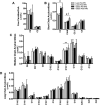Metabolomic analysis reveals altered skeletal muscle amino acid and fatty acid handling in obese humans
- PMID: 25864501
- PMCID: PMC4414721
- DOI: 10.1002/oby.21046
Metabolomic analysis reveals altered skeletal muscle amino acid and fatty acid handling in obese humans
Abstract
Objective: Investigate the effects of obesity and high-fat diet (HFD) exposure on fatty acid oxidation and TCA cycle intermediates and amino acids in skeletal muscle to better characterize energy metabolism.
Methods: Plasma and skeletal muscle metabolomic profiles were measured from lean and obese males before and after a 5-day HFD in the 4 h postprandial condition.
Results: At both time points, plasma short-chain acylcarnitine species (SCAC) were higher in the obese subjects, while the amino acids glycine, histidine, methionine, and citrulline were lower in skeletal muscle of obese subjects. Skeletal muscle medium-chain acylcarnitines (MCAC) C6, C8, C10:2, C10:1, C10, and C12:1 increased in obese subjects, but decreased in lean subjects, from pre- to post-HFD. Plasma content of C10:1 was also decreased in the lean but increased in the obese subjects from pre- to post-HFD. CD36 increased from pre- to post-HFD in obese but not lean subjects.
Conclusions: Lower skeletal muscle amino acid content and accumulation of plasma SCAC in obese subjects could reflect increased anaplerosis for TCA cycle intermediates, while accumulation of MCAC suggests limitations in β-oxidation. These measures may be important markers of or contributors to dysregulated metabolism observed in skeletal muscle of obese humans.
© 2015 The Obesity Society.
Figures





References
-
- Finkelstein EA, Trogdon JG, Cohen JW, Dietz W. Annual medical spending attributable to obesity: payer-and service-specific estimates. Health Aff (Millwood) 2009;28:w822–31. - PubMed
Publication types
MeSH terms
Substances
Grants and funding
LinkOut - more resources
Full Text Sources
Other Literature Sources
Medical

